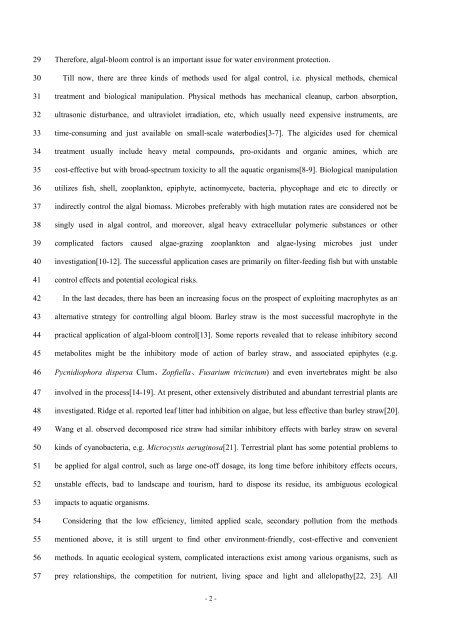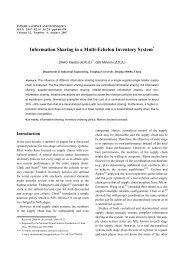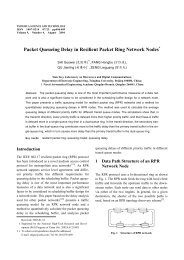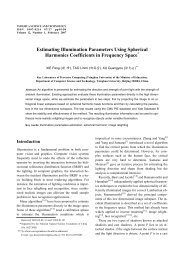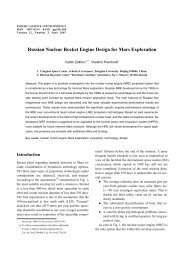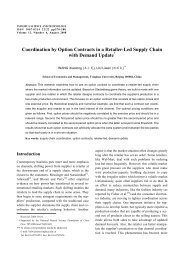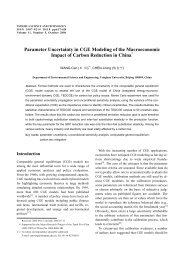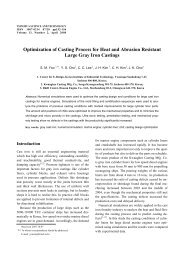Sample Paper_Submission.pdf
Sample Paper_Submission.pdf
Sample Paper_Submission.pdf
You also want an ePaper? Increase the reach of your titles
YUMPU automatically turns print PDFs into web optimized ePapers that Google loves.
29<br />
30<br />
31<br />
32<br />
33<br />
34<br />
35<br />
36<br />
37<br />
38<br />
39<br />
40<br />
41<br />
42<br />
43<br />
44<br />
45<br />
46<br />
47<br />
48<br />
49<br />
50<br />
51<br />
52<br />
53<br />
54<br />
55<br />
56<br />
57<br />
Therefore, algal-bloom control is an important issue for water environment protection.<br />
Till now, there are three kinds of methods used for algal control, i.e. physical methods, chemical<br />
treatment and biological manipulation. Physical methods has mechanical cleanup, carbon absorption,<br />
ultrasonic disturbance, and ultraviolet irradiation, etc, which usually need expensive instruments, are<br />
time-consuming and just available on small-scale waterbodies[3-7]. The algicides used for chemical<br />
treatment usually include heavy metal compounds, pro-oxidants and organic amines, which are<br />
cost-effective but with broad-spectrum toxicity to all the aquatic organisms[8-9]. Biological manipulation<br />
utilizes fish, shell, zooplankton, epiphyte, actinomycete, bacteria, phycophage and etc to directly or<br />
indirectly control the algal biomass. Microbes preferably with high mutation rates are considered not be<br />
singly used in algal control, and moreover, algal heavy extracellular polymeric substances or other<br />
complicated factors caused algae-grazing zooplankton and algae-lysing microbes just under<br />
investigation[10-12]. The successful application cases are primarily on filter-feeding fish but with unstable<br />
control effects and potential ecological risks.<br />
In the last decades, there has been an increasing focus on the prospect of exploiting macrophytes as an<br />
alternative strategy for controlling algal bloom. Barley straw is the most successful macrophyte in the<br />
practical application of algal-bloom control[13]. Some reports revealed that to release inhibitory second<br />
metabolites might be the inhibitory mode of action of barley straw, and associated epiphytes (e.g.<br />
Pycnidiophora dispersa Clum、Zopfiella、Fusarium tricinctum) and even invertebrates might be also<br />
involved in the process[14-19]. At present, other extensively distributed and abundant terrestrial plants are<br />
investigated. Ridge et al. reported leaf litter had inhibition on algae, but less effective than barley straw[20].<br />
Wang et al. observed decomposed rice straw had similar inhibitory effects with barley straw on several<br />
kinds of cyanobacteria, e.g. Microcystis aeruginosa[21]. Terrestrial plant has some potential problems to<br />
be applied for algal control, such as large one-off dosage, its long time before inhibitory effects occurs,<br />
unstable effects, bad to landscape and tourism, hard to dispose its residue, its ambiguous ecological<br />
impacts to aquatic organisms.<br />
Considering that the low efficiency, limited applied scale, secondary pollution from the methods<br />
mentioned above, it is still urgent to find other environment-friendly, cost-effective and convenient<br />
methods. In aquatic ecological system, complicated interactions exist among various organisms, such as<br />
prey relationships, the competition for nutrient, living space and light and allelopathy[22, 23]. All<br />
- 2 -


